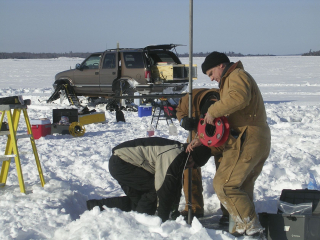Last week, I discussed the impressive cleanup of the Rainy River, including substantial reductions in phosphorus from the paper mills, sewage treatment plants and other sources in the past several decades. The question I left you with was, if phosphorus was reduced, why are we still getting algae blooms?
 University of Minnesota-Duluth and Minnesota Pollution Control Agency researchers work on the ice to collect sediment cores from Lake of the Woods. Each core sample preserves a history of the lake for the last several hundred years. Dan Engstrom/St. Croix Watershed Research StationPhosphorus, algae’s favorite food, stimulates its growth. When algae die and fall to the lake bottom and decompose, the phosphorus is released. Depending on conditions at the bottom of the lake, the phosphorus is either buried as new sediments accumulate on top or it is released back to the lake water. If phosphorus isn’t permanently buried or carried away by lake outflow, it can survive a long time. Scientists are actively studying this in Lake of the Woods – the perfect “live” lab. What they’ve found is that Lake of the Woods has accumulated a pool of “legacy” phosphorus in the lake bottom from past decades of pollution. Phosphorus from the mills and sewage waste of decades past has been returning from the sediments and fueling the algae blooms ever since. This recycling process, called internal loading, means that even with the reductions in pollution since the 1970s, it may take a long time for all the recycling legacy phosphorus to be depleted. The lake has been paying for our past sins.
University of Minnesota-Duluth and Minnesota Pollution Control Agency researchers work on the ice to collect sediment cores from Lake of the Woods. Each core sample preserves a history of the lake for the last several hundred years. Dan Engstrom/St. Croix Watershed Research StationPhosphorus, algae’s favorite food, stimulates its growth. When algae die and fall to the lake bottom and decompose, the phosphorus is released. Depending on conditions at the bottom of the lake, the phosphorus is either buried as new sediments accumulate on top or it is released back to the lake water. If phosphorus isn’t permanently buried or carried away by lake outflow, it can survive a long time. Scientists are actively studying this in Lake of the Woods – the perfect “live” lab. What they’ve found is that Lake of the Woods has accumulated a pool of “legacy” phosphorus in the lake bottom from past decades of pollution. Phosphorus from the mills and sewage waste of decades past has been returning from the sediments and fueling the algae blooms ever since. This recycling process, called internal loading, means that even with the reductions in pollution since the 1970s, it may take a long time for all the recycling legacy phosphorus to be depleted. The lake has been paying for our past sins.
To complicate matters even more, additional changes in the types of algae in the lake have occurred since the 1980s, despite progress in reducing nutrient loads. This is thought to be due to multiple influences, including climate change. What we are left with is a new aquatic ecosystem that we do not completely understand. What is clear, though, is that nutrient pollution has long-term consequences and it’s certainly easier to keep a lake clean in the first place than it is to fix if after the fact.
The good news is that the legacy phosphorus is slowly being flushed out through outflow and burial and has declined to the point that continued reductions of phosphorus from the watershed should be effective. Water stays in the lake for about a year, so progress will be slow. Since we are on the topic of algae, next week I will focus a bit more on the basics of this phenomenon – where does it come from and what’s the big deal?
This series is provided as part of the International Watershed Coordination Program of the Lake of the Woods Water Sustainability Foundation. This story has been compiled from a number of articles from our science partners on our Foundation website blog at https://lowwsf.com/blog.
